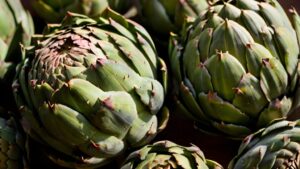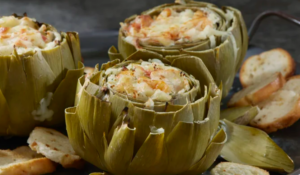If you grew up in the United States, the food of the artichokes you picked up can mean coming to Ken conanker images. There are no significant problems with this choice, and indeed, sometimes you should use can artichokes instead of fresh versions. But if you’ve limited your taste to just tons of artichokes, you’ve been robbed of all the delicious ways these vegetables are prepared and eaten around the world.
If you ever travel to Rome, you will be surprised when you get to see the modest variety of artichokes turned into a special delicious starter. But here, in addition to how to prepare artichokes, a certain nature of them is used. The difference between these two artichokes is that in America we use a type of artichoke with hard leaves and thorns that requires us to suck on the mats of the Patels. But in Italy, if you continue on the romance side, you won’t be afraid to eat the whole vegetable.
What are American artichokes?

In America, we eat mostly globe artichokes, which are French artichokes or their scientific name Canara cardunculus var. Also known as scolimus. These are the artichokes that you will usually see on the crochet. Their color is reddish green, the size varies (increasing to about six inches in diameter of the largest volume), and they have long stems. Their petals are pointed, and their inner layer is green or violet in color to look at. If you eat their leaves raw (especially their outer layers), you will notice that they are stiff and somewhat uninteresting.
Globe artichokes are called “Americans”, but this fame is inherent in Mediterranean and North Africa. Nowadays, even today Italy produces the largest production of artichokes worldwide. But multi-globe artichokes are cultivated in American in California, because this state has a comparable season in the Mediterranean. According to Specialty product, the production of more than 80% of the number of American commercial artichokes belongs to a Marine City called Castroville, which is named the main city of artichokes in the world, and celebrates an annual festival with the nobility that is based on these artichokes.
What are Roman artichokes?

Roman artichokes (Cynara scolymus’ Carciofo Romanesco’) eliminate two non-delicious parts: sharp pointed and hairy squares. The first thing, also called spines or thorns, is the pointed pointed ends of the brackets (occasionally called petals). They are technically edible, but not massively delicious — And we avoid them when eating artichokes the American way. The second is the hairy braid of artichokes, which is a shorter thick hairy edge than the artistic young at the top of the capricious heart. While the heart is soft and tasty, the chowder contains quite hard fibers that do not make you want to chew it, so it is usually removed before cooking the artichoke. Among these vegetables of the Roman version, yes, you have the opportunity to ignore some people with these two objectives.
Roman artichokes, called carciofo Romanescu, mimola, or cimarulo, were born around 1400 in erup. They have shiny violet petals, a grassy aroma, and a soft center that is finely hairless. While this breed is often created in the affected city of California, such as with its global brethren, you will find them on the coastal of itelli laudespoli and cervitari, two US citizens in some centers that are located in the north of Rome. And if you get Memoirs of the genus carciofo romanesco del Lazio, then you will experience a real pleasure, because these special vegetables are a protective Geographical Indication (PGI). Have achieved status.
American artichokes are typically stuffed, steamed, or canned

There are many ways to prepare American artichokes — but still, most of their recipe is made so that the center can be softened and the vegetable of the petals can be very tasty. Boiling them is the most well-known method of this, in which artichokes are usually opened on the stove and boiled in the furnace for 40 minutes. Of course, you can grill them, bake them, or even boil them in the microwave if you are in a hurry. Before boiling, sometimes the Square is removed, and the pointed tips are also cut off.
Artichokes in the United States are usually made delicious with melted butter and lemon juice to give the original beauty of fresh vegetables a look. Of course, they can be prepared by filling them with parmesan and breadcrumbs or even with a sneaky cheese sauce. Whatever toppings you use, hopefully you’ll peel and eat the leaves of your ripe artichokes, then chew them and remove the soft parts. For this reason, if you just want to add them to the portion of a dish, you may also be much better off taking beans rather than eating them. In the US, they are usually eaten mixed in the famous spinach artichoke dip or A vegan tuna is mixed into a salad.
Roman artichokes are usually braised or fried

If you’ve ever visited Italy, you may have enjoyed” carciofi alla Romana “or” Roman style artichokes.”As we mentioned, Italian food specialists do not need to cut off pointed thorns or extract the square to prepare this dish, since in Roman artichokes these two elements are not so much. To prepare this dish, you need to add salt, pepper, white wine, lemon, garlic, olive oil, parsley, and mintokia, which is a kind of hot ointment.
Mix spices, Lake and olive oil, fill in the center of the flowers and squeeze them in lemon water. Then, transfer them to the center of olive oil and wine, where let them sauté for a half hour. They will soften by the time you even cut them off with an ax when they are presented with anopsis down.
But if you enjoy them in Rome, do not smell it secondly before leaving the city: carciofi alla goida, or, Roman Jewish artichokes. In opposition to the Romana recipe, you can eat them with your own hands, and their surface is like strip chips. You first remove the strip of outer leaves, then dip them in lemon water and beat them to open. Then, you will fry them twice-for the first time on low heat so that they brown and their straps open further, then again on high heat so that they crisp beautifully

